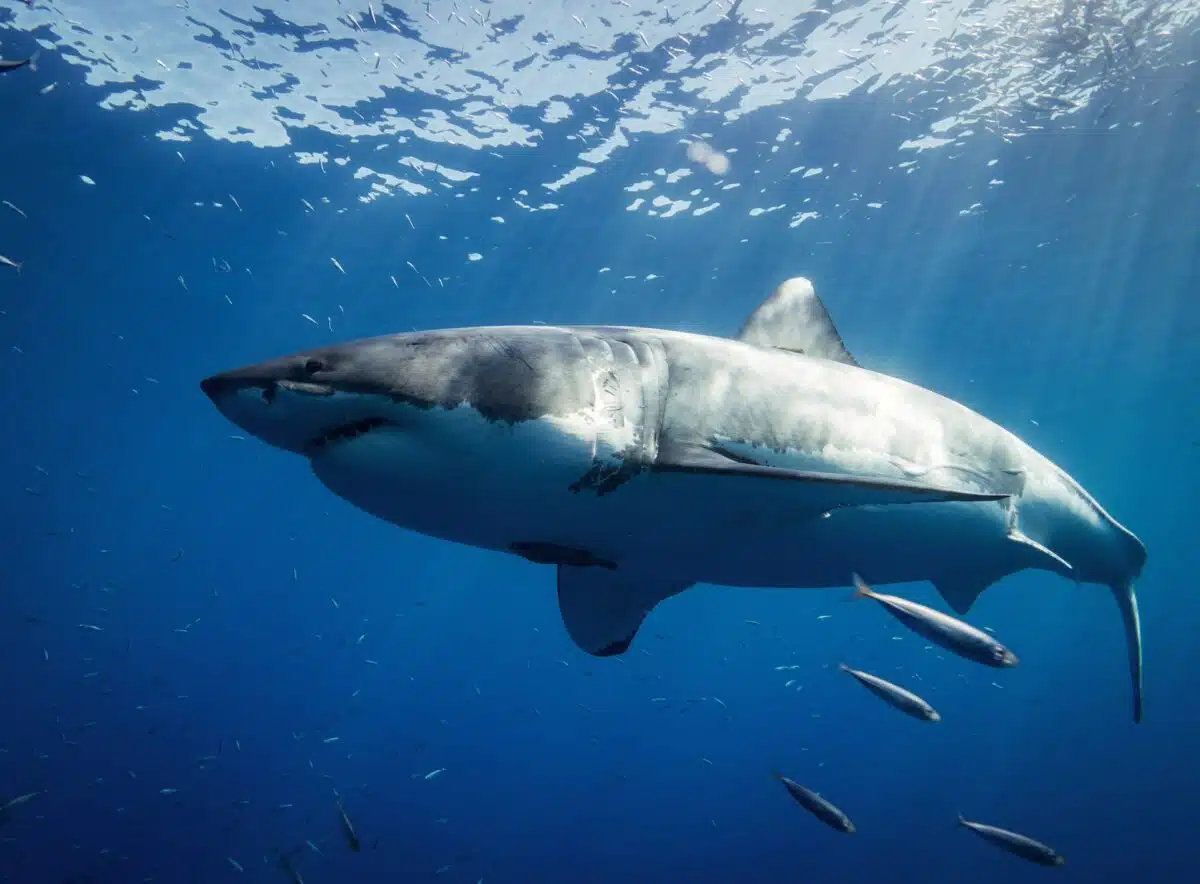Have you ever wondered what it’s like to come face to face with the largest great white shark ever recorded?
Join us as we dive into the world of the biggest great white shark ever recorded. We’ll explore its massive size, its hunting habits, and what makes it such a fascinating and fearsome predator.
If you’re thinking of seeing this predator up close, take a look at our article about Great White Shark Diving.
Want to swim ahead? Click below.
Key Points on Deep Blue
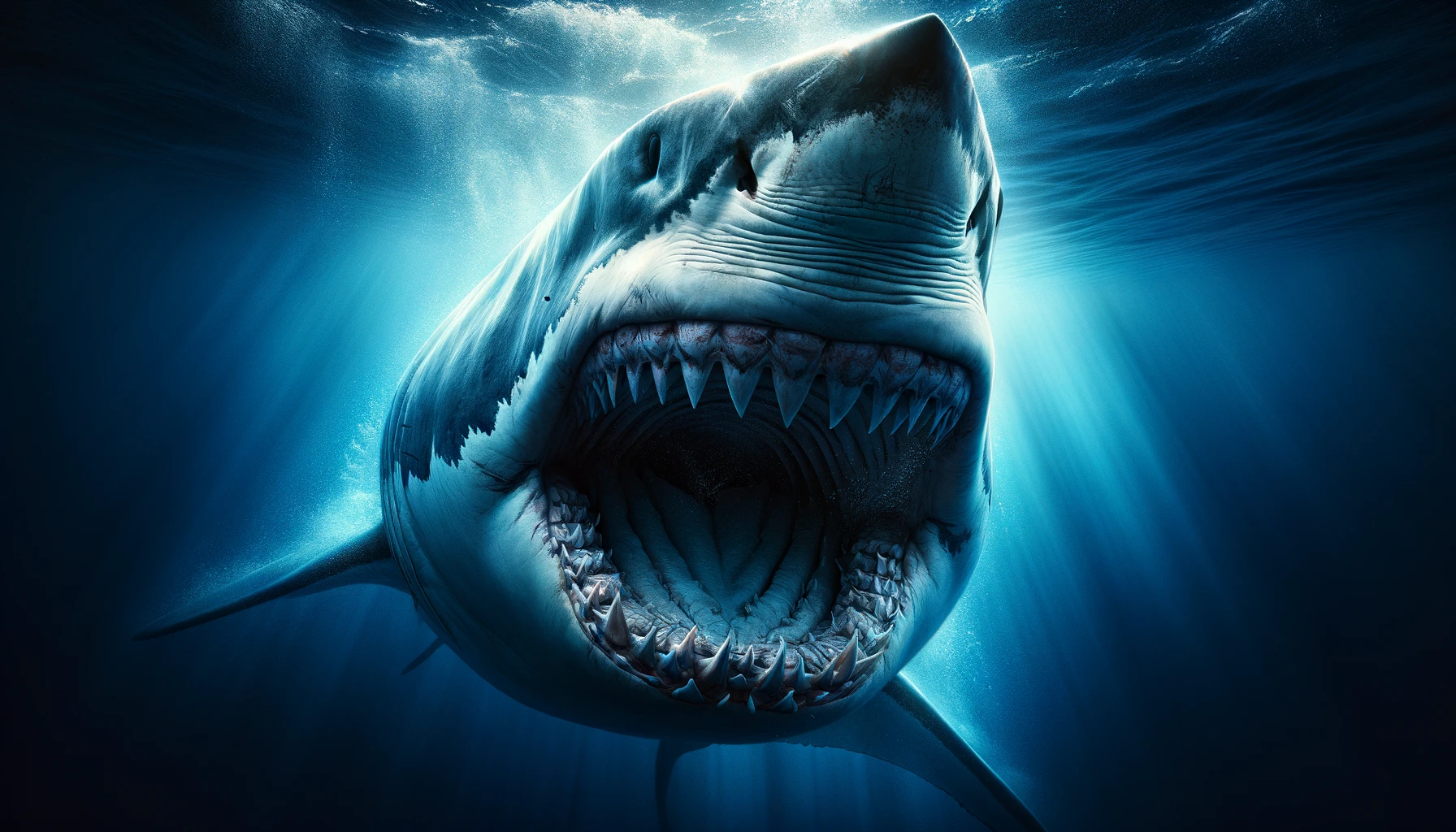
| Key Points | Details |
|---|---|
| Species | Great White Shark |
| Biggest Shark Ever Recorded | Spotted in November 2013 off Guadalupe Island |
| Length | Over 20 feet (more than 6 meters) |
| Weight | More than 5,000 pounds (2.5 tons) |
| Identification | Known as “Deep Blue” |
| Hunting Habits | Apex predator with hunting techniques like breaching |
| Mating Habits | Unique courtship ritual involving biting for mating |
| Migration Patterns | Highly migratory, traveling thousands of miles |
| Impact on Ecosystem | Maintains balance in ocean ecosystems as an apex predator |
| Threats | Overfishing, habitat loss, and climate change |
| Conservation Importance | Understanding behavior and biology for protection |
| Impact of Climate Change | Threatened by changes in prey availability and ocean chemistry |
| Future of Great White Sharks | Studying and protecting to ensure their survival |
| Educational Resources | Resources on Shark Cage Diving and Self-defense against Shark Attacks |
Background Information about the Great White Shark
The great white shark is one of the world’s most recognizable creatures, thanks in no small part to its place in pop culture. From movies like Jaws to documentaries about shark conservation, great white sharks have captured the public like few other animals. But what do we know about these predators?
For starters, great white sharks are found in almost every ocean, from temperate waters to tropical seas. They are apex predators, meaning they sit at the top of the food chain and have only a few natural predators of their own, like Orcas. If you want to read more about the deadly duo of Orca’s hunting great white Sharks, we have some amazing footage that you might want to check out!
Details about the Biggest Great White Shark Ever Recorded
Now that we’ve established some background information about great white sharks, let’s turn our attention to the biggest one ever recorded.
This massive predator was first spotted in 2013 off the coast of Mexico’s Guadalupe Island, and it immediately made headlines around the world. For reference the Guadalupe islands were for many years one of the top places to go shark diving but unfortuantely that is no longer the case, read more about this with our article on Shark Cage diving.
Here are some key details about this incredible animal:
| Characteristic | Measurements |
|---|---|
| When and Where It Was Spotted | November 2013, Guadalupe Island |
| Length | Over 20 feet (more than 6 meters) |
| Weight | More than 5,000 pounds (2.5 tons) |
| Identification | Deep Blue |
Details of the Biggest Great White Shark Ever Recorded
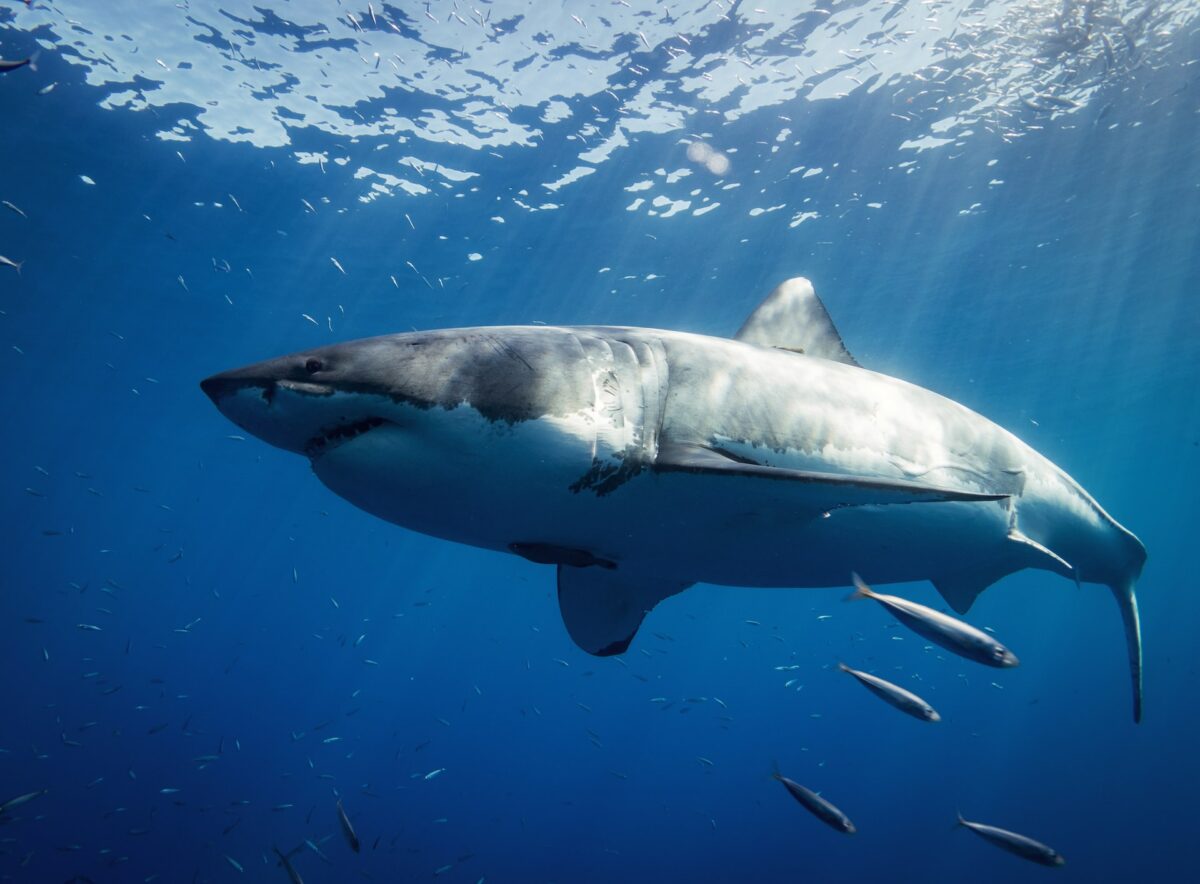
To determine the size, this research team used a combination of underwater footage and photographs. As well as measurements taken from the baited hooks. They also consulted with other experts in the field to confirm their findings. Based on their analysis, the team concluded that this was indeed the biggest great white shark ever recorded.
Physical Characteristics of the Shark

So, what makes this shark so massive? According to scientists, it’s likely a combination of genetics, age, and diet. The shark is estimated to be around 50 years old. This is relatively old for a great white shark. It is also possible that it has access to a particularly abundant food source. It has allowed it to grow larger than most other individuals of its species.
In terms of physical characteristics, the biggest great white shark ever recorded is a truly massive creature. Evidently, its size makes it easy to spot even from a distance. Its serrated teeth are a reminder of its formidable hunting abilities.
| Creature | Length | Weight |
|---|---|---|
| Blue Whale | Up to 100 feet | Up to 200 tons |
| Giant Squid | Up to 43 feet | Up to 600 pounds |
| Killer Whale (Orca) | Up to 32 feet | Up to 6 tons |
| Saltwater Crocodile | Up to 23 feet | Up to 2,200 pounds |
| Sperm Whale | Up to 60 feet | Up to 60 tons |
| Giant Manta Ray | Up to 23 feet wingspan | Up to 3,000 pounds |
Overall, it’s clear that the biggest great white shark ever recorded is an impressive animal, but there are many other large sea creatures that dwarf it in size, read more about the largest animal in the sea with another one of our aritcles. However, size isn’t everything, and great white sharks are still one of the most fearsome predators in the ocean. Their reputation as apex predators is well-deserved, and they play an important role in maintaining the balance of ocean ecosystems.
How the Biggest Great White Shark Behaves
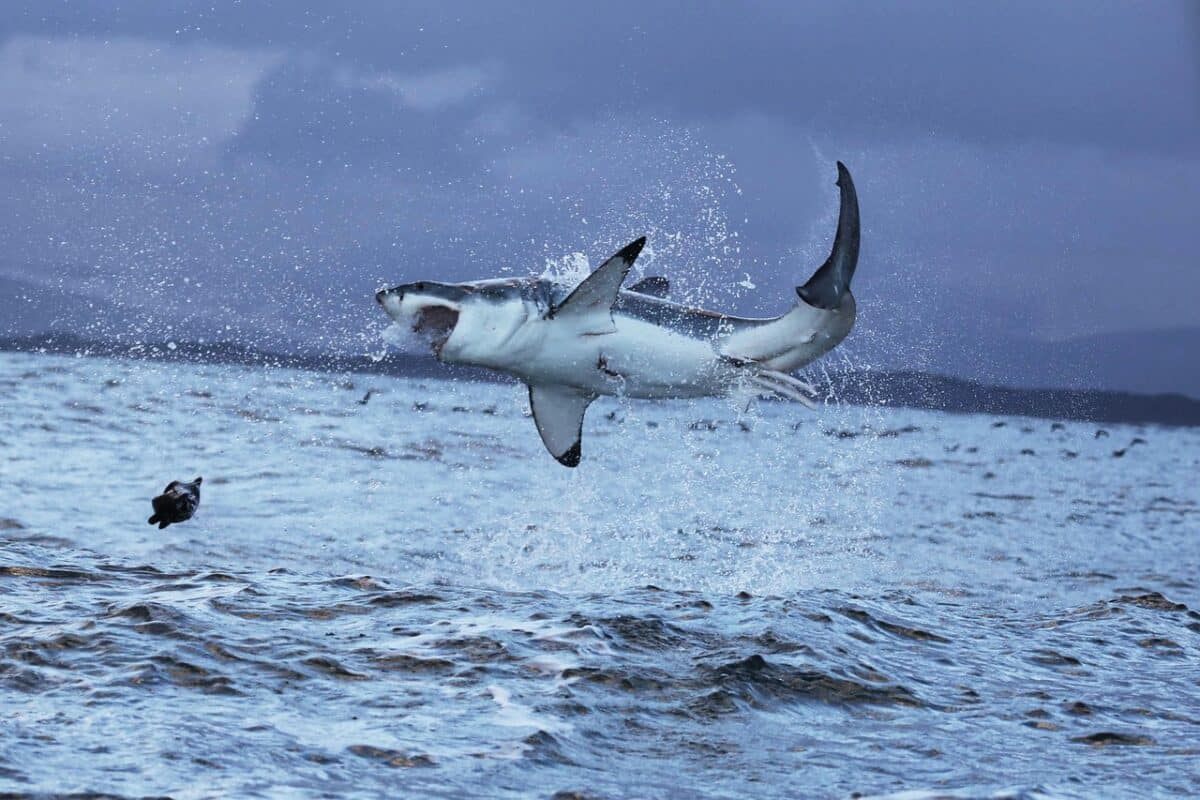
Hunting
One of the most striking things about great white shark behavior is their hunting habits. They are apex predators. This means they sit at the top of the food chain and have very few natural predators (Orcas). They are known for their incredible ability to hunt and kill their prey, which includes sea lions, seals, fish, and even other sharks.
Great white sharks use a variety of hunting techniques. One of their most famous tactics is breaching. This is where they launch themselves out of the water to catch their prey by surprise. They also use their incredible sense of smell to locate their prey from great distances. As well as they can detect a single drop of blood in an Olympic-sized swimming pool.
One of the most incredible things about Deep Blue’s hunting habits was her use of breaching. This is a tactic where the shark launches itself out of the water to catch its prey by surprise.
Deep Blue was known for using this technique. It was an awe-inspiring sight to see this massive creature launch herself out of the water.
Mating
Another interesting aspect of great white shark behavior is their mating habits. Like many animals, great white sharks have a unique courtship ritual. It involves the male biting the female to assert his dominance. This is not a violent act but rather a way of testing the female’s receptiveness to mating.
Migration
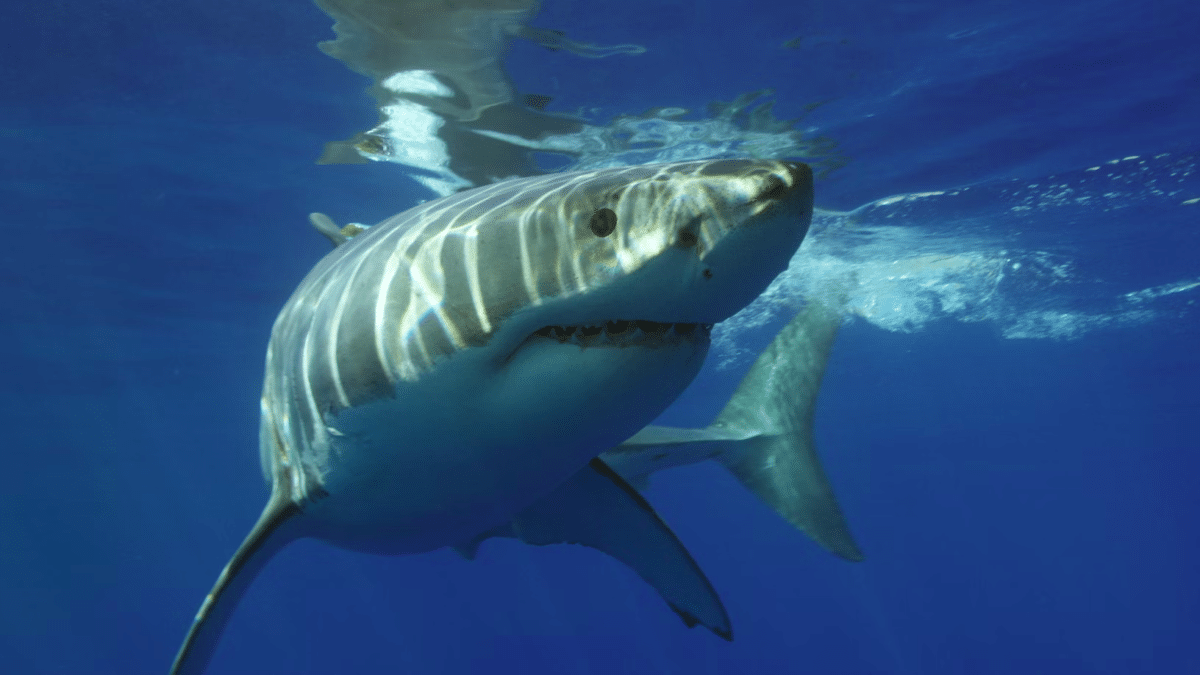
Great white sharks are also known for their migration patterns. These highly mobile creatures are capable of journeying thousands of miles in search of food and breeding grounds. Their habitat ranges from shallow coastal waters to deep open ocean environments, making them one of the most adaptable predators in the ocean. This is one of the reasons they aren’t found in any aquariums, something you can read more about in our article on Why No Aquarium Has A Great White Shark.
Great white sharks are known to migrate across vast distances, and Deep Blue was no exception. She was tagged in 1999 off the coast of Mexico, and her movements were tracked for many years afterward. She was known to travel as far north as Hawaii. And as far south as the waters off the coast of New Zealand.
One of the most interesting things about Deep Blue’s migration patterns was her visit to the waters off the coast of Hawaii. This is a location where a large number of tiger sharks congregate. And it is unusual for great white sharks to visit this area.
However, Deep Blue was spotted there in 2019. It is believed that she may have been drawn to the area by the abundance of food.
In addition to her unusual visit to the waters off the coast of Hawaii, Deep Blue was also known for her annual migrations. These migrations were to the waters off the coast of California. This is a location where a large number of elephant seals congregate. And it is an ideal feeding ground for great white sharks.
The Significance of the Biggest Great White Shark and Identified

Great white sharks have captured our imagination for decades, starring in blockbuster movies and being featured in documentaries. But beyond their pop culture appeal, these majestic predators play a crucial role in the ocean’s ecosystem.
As apex predators, they help to regulate the populations of other marine animals, keeping the ocean’s ecosystem in balance. But despite their importance, great white sharks face numerous threats, including overfishing, habitat loss, and climate change.
Implications of Having Such a Large Individual
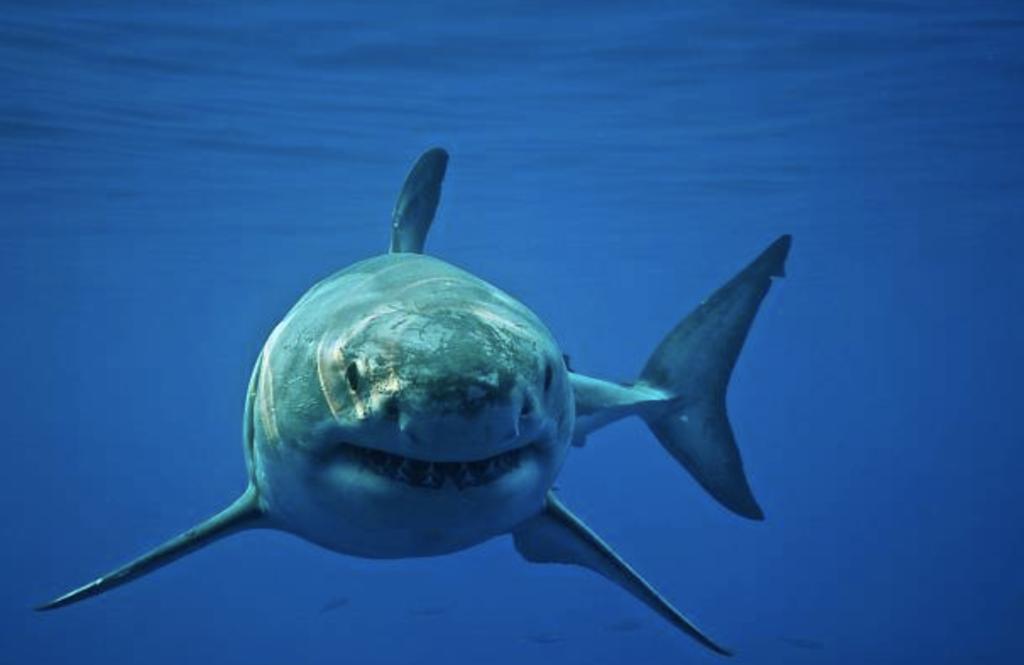
Understanding the behavior and biology of great white sharks is crucial to protecting them. The discovery of the biggest great white shark ever recorded provides researchers with valuable information not only about these animals’ growth patterns but also about their behavior.
The biggest great white shark on record was an enormous female shark named “Deep Blue.” This magnificent creature was over 20 feet long and weighed an estimated 2.5 tons.
Her behavior was just as impressive as her size, and she was known for her unique hunting habits, mating rituals, and migration patterns.
Impact of Climate Change on Great White Shark Populations
Climate change poses a significant threat to the ocean’s ecosystem, including great white sharks. As ocean temperatures rise, it could lead to changes in prey availability, as well as changes in migration patterns and affecting the distribution of these sharks.
Additionally, climate change could also lead to changes in the ocean’s chemistry, which could impact the development of great white shark embryos. Increased ocean acidity could make it harder for sharks to form their teeth and skeletons, making it harder for them to survive and thrive.
Wrapping Up with the Largest Great White ever recorded
The biggest great white shark ever recorded is more than a massive creature lurking beneath the surface. It’s a symbol of these apex predators’ vital role in the ocean’s ecosystem. Furthermore, a reminder of the threats they face.
By studying and protecting these majestic animals, we can ensure that they continue to roam the ocean’s depths for generations to come.
So the next time you’re at the beach, take a moment to appreciate the beast beneath the surface. As well as the awe-inspiring power it represents.
There are still many things to learn about these sharks and even Shark Cage Diving, So check out our articles on Shark Cage Diving: A sinking industry?, and also How to Defend Yourself Against Shark Attacks.
Frequently Asked Questions (FAQs)
Great white sharks have not left South Africa. These magnificent predators are known to frequent the waters off the South African coast, particularly around places like Cape Town and False Bay. However, shark populations and migration patterns can be influenced by various factors, including environmental changes, food availability, and human activities. It’s always best to consult local marine experts and authorities for the most up-to-date information on shark sightings and behavior in specific regions.
Great white sharks are often considered one of the deadliest predators in the ocean due to their impressive size, power, and hunting abilities. As apex predators, they sit at the top of the marine food chain and have few natural predators. Their hunting techniques, such as breaching and ambush attacks, make them formidable hunters capable of taking down large marine mammals and other sharks. It’s essential to remember that while great white sharks are powerful and should be treated with respect, they are not typically a threat to humans and do not seek them out as prey.
As apex predators, adult great white sharks have few natural predators in the ocean. However, young and smaller individuals may face threats from larger sharks, such as adult orcas (killer whales) and larger species like tiger sharks. In some cases, humans have been known to hunt great white sharks, contributing to their conservation status as vulnerable.
Sharks are top predators and are not typically afraid of other animals. However, some marine mammals, such as orcas and certain types of dolphins, are known to be potential threats to sharks. Orcas, in particular, have been observed hunting and even preying on great white sharks in some regions.
While it’s not entirely accurate to say that sharks are afraid of dolphins, some dolphins, such as orcas, are known to be potential threats to sharks. Orcas are highly intelligent and skilled predators that have been observed hunting and killing sharks. It is believed that orcas’ coordinated hunting behavior and their ability to take on larger prey make them a formidable adversary for sharks.
Thanks for following along with us!
Next up:
Join our Forum for free today!

- Big Cats Love Mouthing Affection - July 22, 2024
- Kind Elephant Merciful To Lion Cubs - July 22, 2024
- Beachgoers Save Massive Shark Stranded In Florida - July 22, 2024

